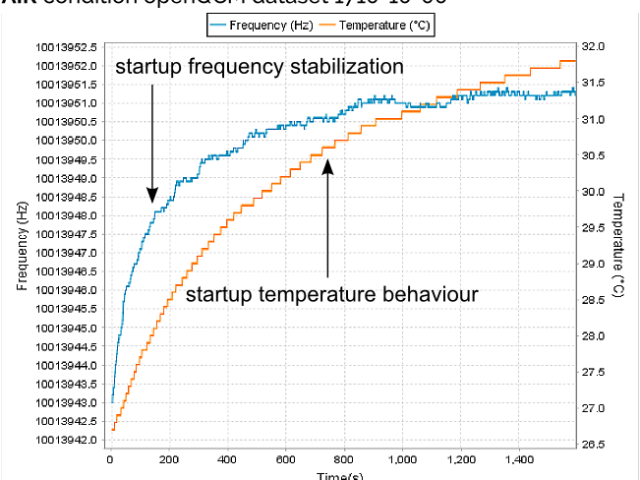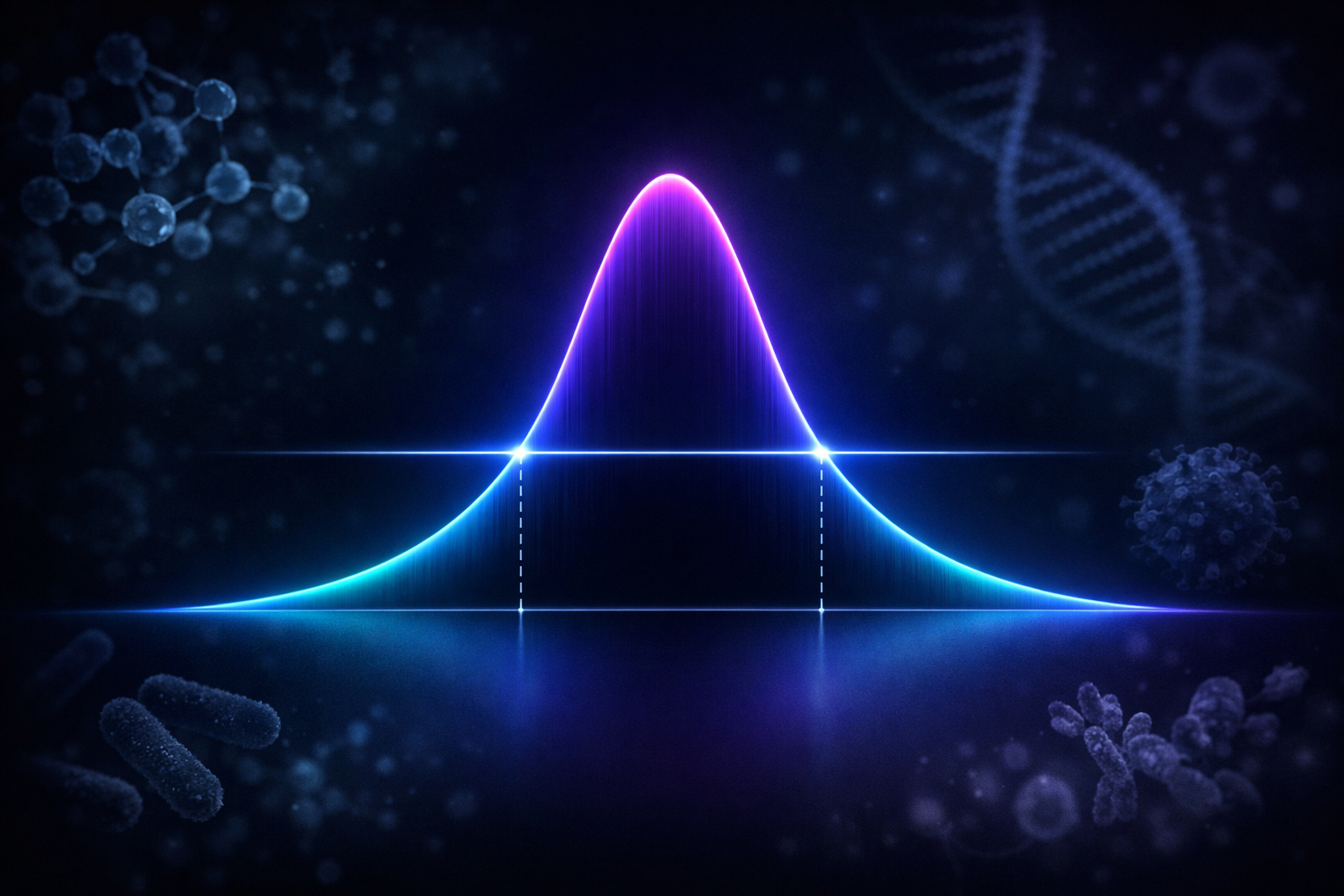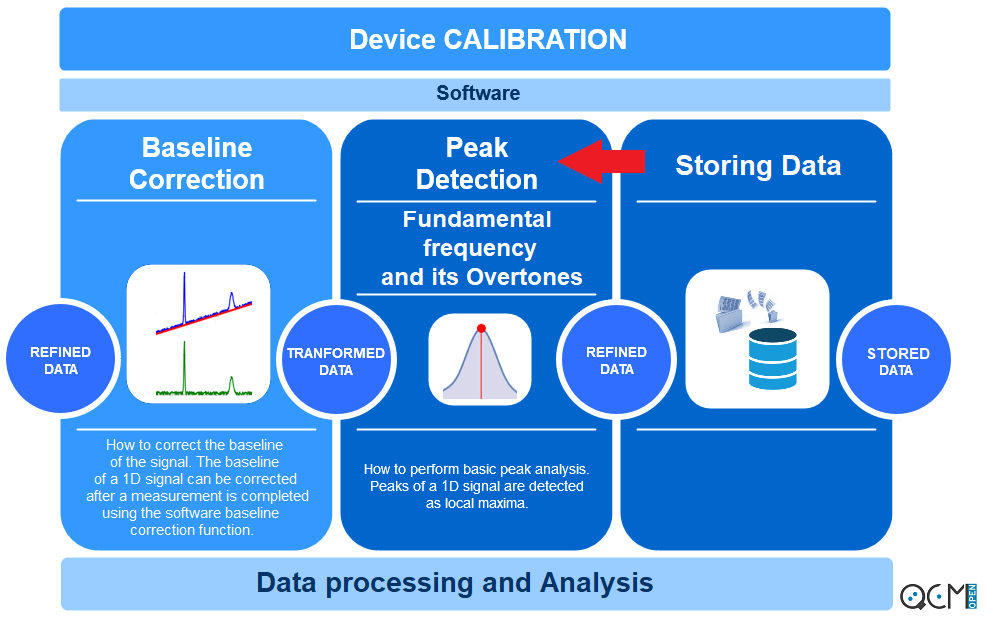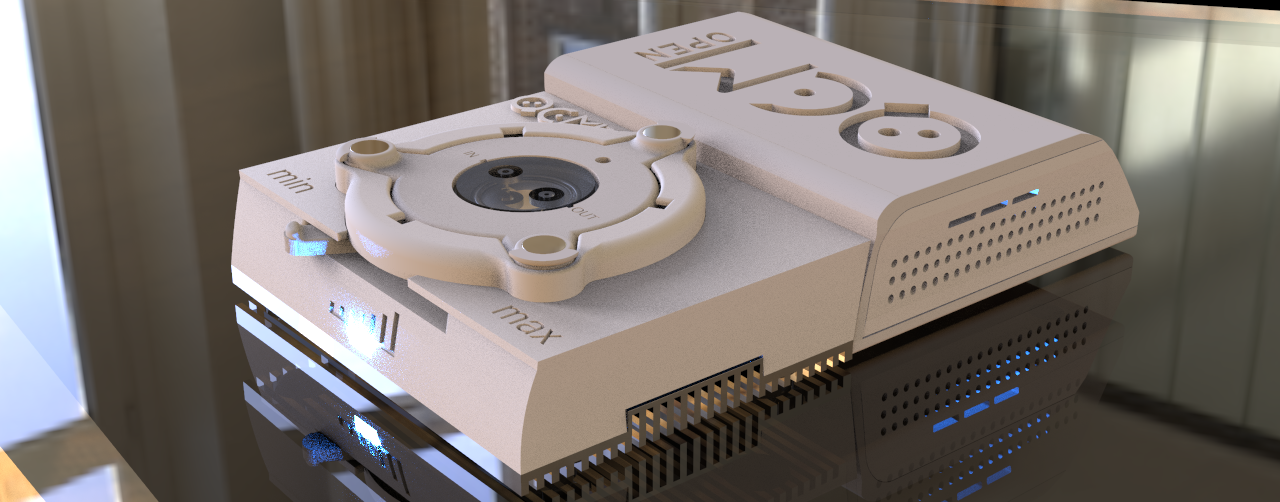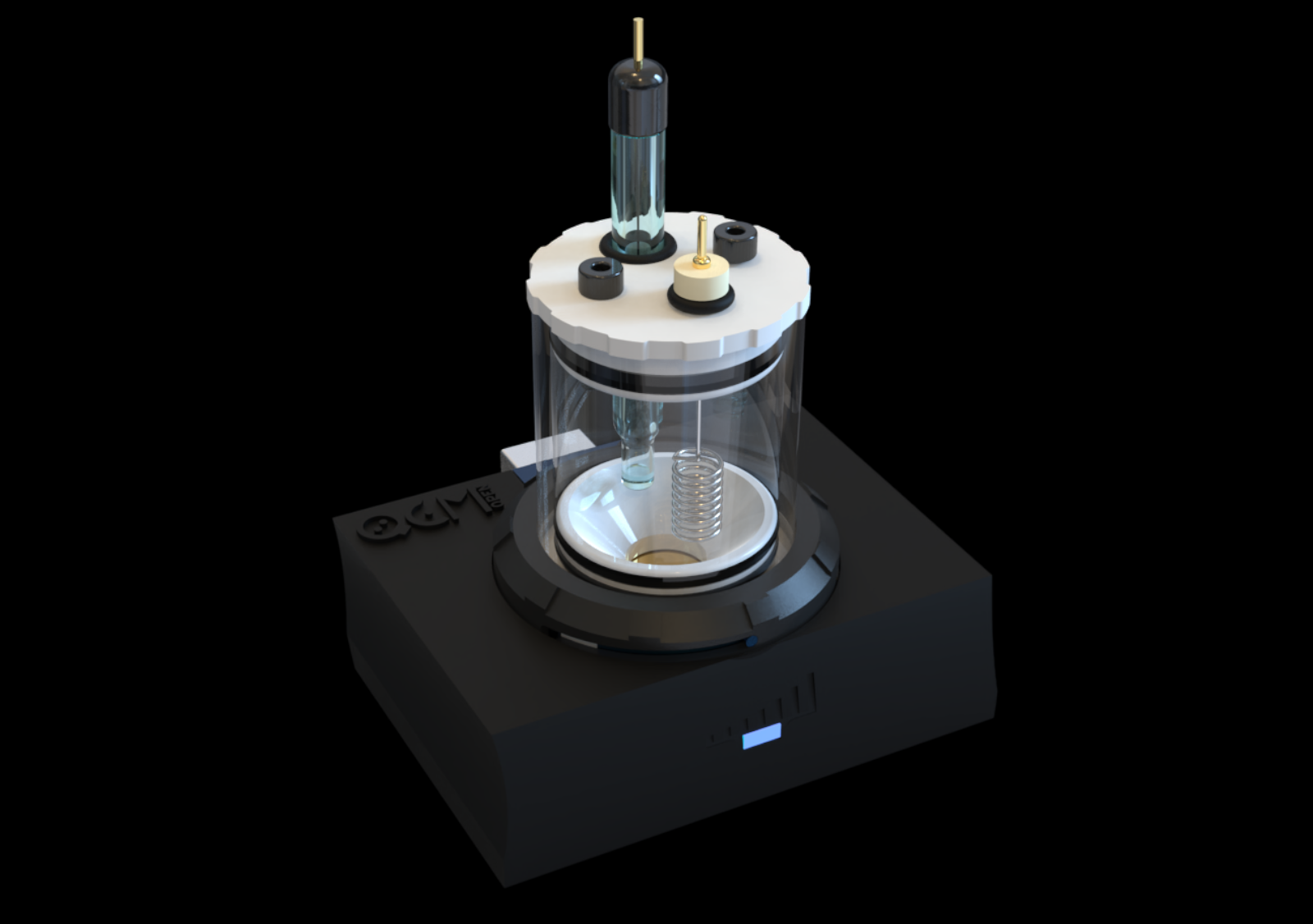We are now testing the performances of two different openQCM devices in the most typical experimental conditions in order to measure the frequency stability of the open source quartz crystal microbalance.
openQCM is above all an open hardware scientific device. I think that the better way to introduce openQCM to the scientific community is sharing the raw data and their (possible) interpretation. I really hope that our customers working in the scientific community may love openQCM as much as we love it.
openQCM has been tested in 3 different experimental conditions:
- Air the quartz crystal sensor is enclosed in the measurement chamber
- Static liquid the measurement chamber is filled with liquid
- Flowing liquid the liquid in the measurement chamber flows at a constant rate
Typically, these are the main working conditions of a Quartz Crystal Microbalance. They have to be considered very different environmental conditions, because each of them shows peculiar operational characteristics. The main goal of the experimental test is to measuring the stability of the quartz crystal frequency signal in these working conditions.
We have used an AT-cut quartz crystal sensor with nominal frequency of 10 MHz, with gold electrode of 6 mm diameter. The liquid in the measurement chamber is distilled water, pure at 99%. The fluid is pumped at a constant rate using a peristaltic pump.
The quartz crystal frequency and temperature data over the entire experiment using two different openQCM devices are shown in Figure 1 and Figure 2
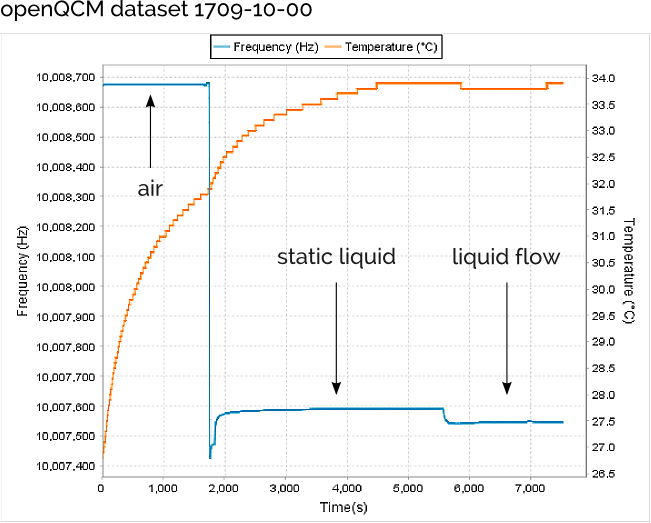

First some words about the temperature signal. At the openQCM start up the temperature grows fast. This is caused by the electronic board warming. It happens every time, so I suggest to power on the openQCM roughly one hour before the test. Once the measurement chamber is filled with water, you can see that the temperature grows faster and a little bit more. That’s why the viscous, damping load over the quartz crystal surface needs more electrical current from the crystal driver in order to sustain the vibration at the resonance. Sometimes in flowing liquid conditions the temperature is a little bit lower because the flowing fluid acts like a refrigerator.
In the first experimental phase, we measure the frequency at the start up in air conditions. This start up procedure is necessary both for the thermalization process and for reaching the quartz crystal resonance frequency. It is also very interesting in order to verify if some long term drifts occurs in the frequency signal. Long term drifts are mainly caused by temperature variations and mechanical stress, such as not-uniform mechanical pressure on quartz crystal surface and not-working mechanical connection.
The quartz crystal frequency and temperature raw data at the start up in air conditions using two different openQCM devices are shown in Figure 3 and Figure 4.
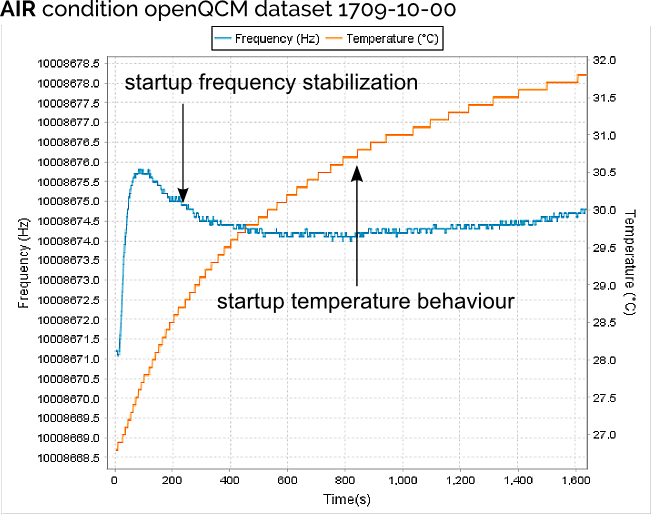
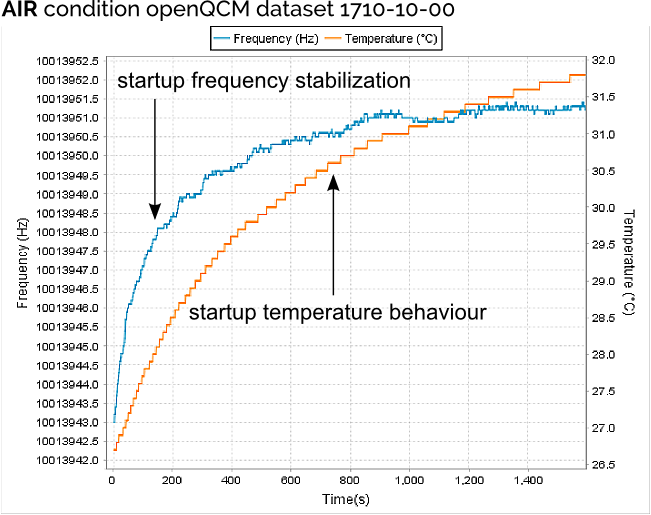
The start up temperature behavior is quite straightforward, it grows with an exponential trend to the equilibrium temperature. For both openQCM devices the total temperature variations during the start up procedure is roughly 5° C and it is reached in about 30 minute.
The start up quartz crystal frequency behavior needs some words. At the start up the factors conditioning the frequency stabilization are various and can not be decoupled. The main factors are: temperature variations, mechanical stress release (caused by oring and mechanical contact) and quartz crystal resonant circuit transient. That’s why the frequency start up behavior of the two openQCM looks quite different. The openQCM 1709 shows an abrupt increase of the frequency followed by a smooth relaxation process, while the openQCM 1710 has an exponential approach to the equilibrium frequency which definitely follows that of the temperature. Even though the qualitative behavior is quite different, what is more important is that the frequency stability is reached quickly in a time interval inferior to 30 minutes for both openQCM devices.
At the steady state in air conditions the frequency mean value and standard deviation are measured over a time interval of about 15 minutes
| Frequency mean (Hz) | Frequency SD (Hz) | |
| openQCM 1709 | 10008674.3 | 0.1 |
| openQCM 1710 | 10013951.0 | 0.3 |
Table 1 Frequency mean and standard deviation in AIR ambient condition for two different openQCM devices
When the equilibrium in air ambient condition was reached, the measurement chamber was filled with pure water using a peristaltic pump. The injection raw data are shown in Figure 5 and Figure 6. After the injection the peristaltic pump was turned off waiting for the equilibrium in static liquid conditions.


The water injection causes an abrupt decrease of the quartz crystal frequency. This is caused by the sudden variation in the load capacitance of the quartz crystal because one side of which is now facing the viscous / damping liquid. The quartz crystal resonant circuit reaches the new resonance frequency in a short time, roughly 5 minutes. Then the board overheating due to the increase of the electrical current in the resonant circuit, causes the longer approach to the equilibrium frequency in static liquid condition. For both openQCM devices it takes roughly 20 minutes.
After the openQCM devices reaches the steady state, we wait for a longer time in order to verify that no long term frequency drifts occurs. At the steady state in static liquid conditions the frequency mean value and standard deviation are measured over a time interval of about 15 minutes
| Frequency mean (Hz) | Frequency SD (Hz) | |
| openQCM 1709 | 10007592.8 | 0.2 |
| openQCM 1710 | 10012749.2 | 0.4 |
Table 2 Frequency mean and standard deviation in Static Liquid ambient condition for two different openQCM devices
It is really interesting to measure openQCM frequency shift between air and liquid. The frequency shift depends on the density and viscosity of the liquid, according to Kanazawa and Gordon equation. By comparing the mean frequency Table 1 and Table 2 the frequency shift between air and liquid is shown in Table 3
| Frequency Shift Air – Liquid | |
| openQCM 1709 | 1081.5 Hz |
| openQCM 1710 | 1201.8 Hz |
Table 3 Frequency shift between air and liquid for two different openQCM devices.
The frequency shifts slightly differs because the volume of the cell measurement chamber is a little bit different due to the tolerance in cell production process. I guess also other kind of factors can cause the observed difference, for example roughness of quartz crystal sensor and pressure on quartz crystal surface.
Finally, we switched on the peristaltic pump in order to observe the openQCM frequency behavior in flowing liquid conditions. The pump flow rate is fixed at 1 ml/min. The quartz crystal frequency and temperature raw data in flowing liquid conditions using two different openQCM devices are shown in Figure 7 and Figure 8
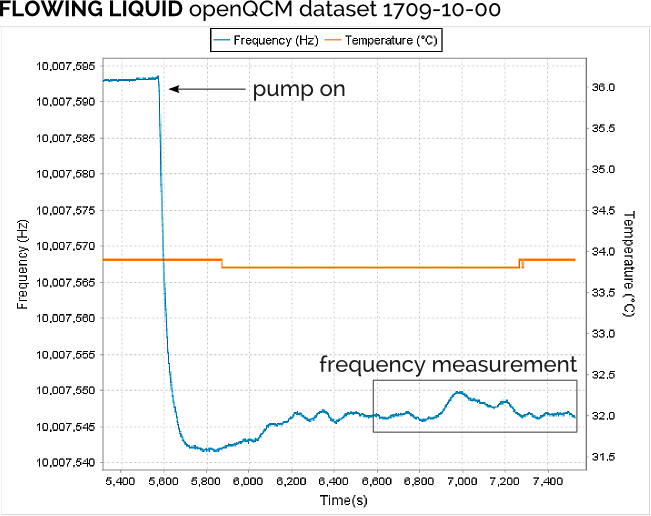

Once the pump is switched on an abrupt decrease in the frequency is observed. This is caused by the sudden variation in the pressure over the quartz surface due to pumping flow. The phenomenon is transient, it occurs in a few seconds and causes a frequency variation of about 50 Hz for both openQCM devices. After the pump is switched on we wait for a new frequency equilibrium.
At the steady state in flowing liquid conditions the frequency mean value and standard deviation are measured over a time interval of about 15 minutes:
| Frequency mean (Hz) | Frequency SD (Hz) | |
| openQCM 1709 | 10007547.2 | 1.1 |
| openQCM 1710 | 10012722.2 | 1.4 |
Table 4 Frequency mean and standard deviation in Flowing Liquid ambient condition for two different openQCM devices
Of course the noise in flowing liquid is greater than the others experimental conditions because of the noise introduced by the peristaltic pump. But we can assure that the frequency stability is very high also in this noisy ambient showing a standard deviation of about 1 Hz at the steady state regime. That’s a good results definitely!
Conclusions
In this post I have introduced for the very first time the openQCM performances in the most typical experimental condition: air, static liquid and flowing liquid.
The main aim of the raw data analysis is showing the quartz frequency stability, the qualitative behavior of the sensor both in the transient regime and at the steady state.
The raw data analysis shows that the equilibrium time and frequency noise is very similar for both openQCM devices. In addition, the air-liquid frequency shift of the openQCM devices is comparable. The qualitative behavior of openQCM devices is also very similar demonstrating the reproducibility of the devices performances.
…and more
I really appreciate if someone else would take a look to the raw data, both for checking my interpretation or for providing a different, better one. For this reason I am glad to share the raw data set acquired in the experimental test. We love to share our results because we believe that science has to be much open!
You can download the raw data file at the following link
In addition, I have developed a simple Java software for openQCM data visualization and processing, you can download zip folder of the executable software at this link (note: it only runs on java JRE 8). I will submit the code on github as soon as I can.
cheers
mm


